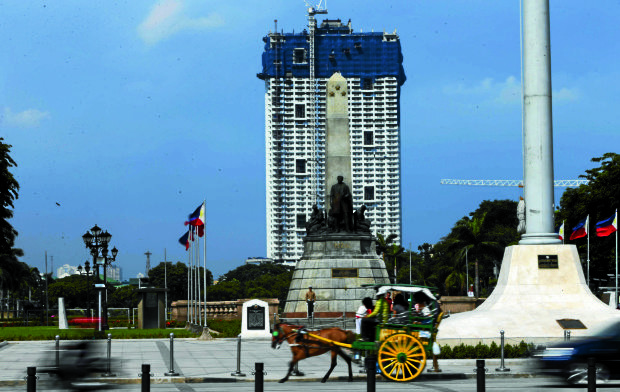Derisively called “Terror de Manila” and “pambansang photobomb,” the planned 49-story Torre de Manila apartment building on Taft Avenue in Ermita, Manila, received criticisms and drew protests for ruining the view of the Rizal Monument.
In June 2012, when it was granted zoning permit, tour guide and activist Carlos Celdran launched an online campaign against the construction of the project, saying that the structure would mar the view of the iconic monument of national hero Dr. Jose Rizal at Luneta.
In July of the same year, the city government of Manila, under the administration of then Mayor Alfredo Lim, granted a building permit to developer DM Consunji Inc. (DMCI) Homes after it submitted all requirements, including approval from the city planning office in the form of a zoning permit.
In November 2013, months after former President and now Manila Mayor Joseph Estrada took over, the City Council suspended the project’s construction citing zoning violations. However, construction continued after the Manila Zoning Board of Adjustments and Appeals granted DMCI an exemption from the zoning regulation.
In September 2014, the Knights of Rizal, along with Las Damas de Rizal Philippines Inc., filed a petition in the Supreme Court to stop DMCI from proceeding with the project and to order the “immediate and complete demolition” of Torre de Manila.
The group sought the building’s demolition because it allegedly violated several laws protecting national heritage sites, including the local zoning ordinance that allows only school and government buildings of up to seven stories to be built in that part of Manila.
At the time, construction was around 23-percent complete, having reached 19 floors.
In November 2014, the high court ordered the inclusion of the National Commission on Culture and the Arts (NCCA), National Museum of the Philippines, National Historical Commission of the Philippines and Manila city officials as interveners in the case.
Hearings on the Torre de Manila project were also conducted in the House of Representatives and Senate in 2014.
On Jan. 5, 2015, the NCCA issued a cease and desist order on the structure. The order was served on the Torre work site on Jan. 13. The agency said the order would be implemented indefinitely until it determined whether construction of the building “destroys or significantly alters the landscape” of the Rizal Monument.
The NCCA, however, claimed that DMCI had not abided by the order as shown by footage of ongoing construction at the work site.
On June 16, 2015, the Supreme Court issued a temporary restraining order (TRO) to suspend the construction of the building. Aside from arguments that the building desecrated the shrine and burial ground of the national hero, issues of procedural infirmities involving the Manila city government also emerged during the earlier oral arguments.
In August 2015, Solicitor General Florin Hilbay called on the Supreme Court to order
DMCI to demolish the Torre de Manila not only for marring the view of the Rizal Monument but also for building it with undue haste using invalid permits.
In October 2015, DMCI asked the high court to lift the TRO. The Supreme Court began to tackle the plea of the company in September last year.
Torre de Manila is planned to have 49 floors, including 41 floors for residential units, four levels for podium parking space, three for basement parking and a ground floor for various amenities. It has a land area of 7,448 square meters. —MARIELLE MEDINA, INQUIRER RESEARCH
Source: Inquirer Archives
